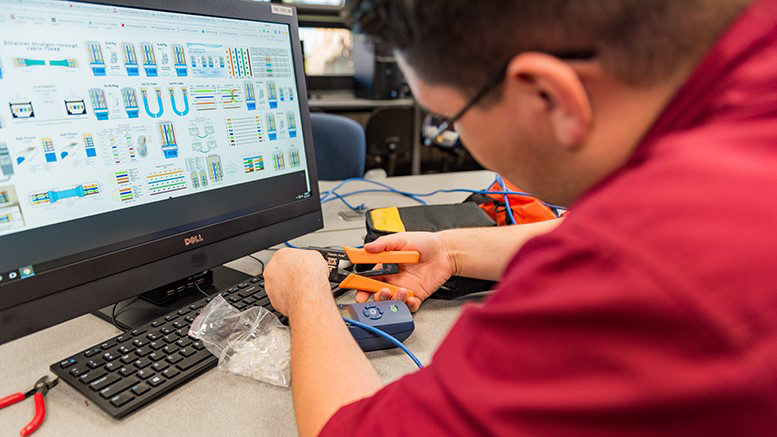A job opening for an information technology professor at Florida State College at Jacksonville attracted just a handful of applications. None of them panned out, so the college reopened the search.
“We’ve probably had five or six failed searches this year,” said Mark Lacey, the chief human resource officer. “Normally, we have one or two at the most.”
Meanwhile, Julia di Liberti, a humanities professor at the College of DuPage in Illinois, worries about colleagues at her community college and others who have lost adjunct teaching roles as fewer students enroll in general education and liberal arts classes.
“The pandemic reduced the numbers of course sections, so you’re always bumping a part-timer, whether you want to or not,” said di Liberti, who is president of the Illinois Community College Faculty Association (ICCFA).
Few job applicants
Community colleges around the country are facing multiple staffing challenges as the pandemic continues to disrupt education, the workforce, and the lives of students and staffers.
Retirements and resignations among faculty and staff are more frequent and more abrupt than in years past, college leaders say. Vacancies are often difficult to fill — especially in high-demand career fields. While employers plead for schools to train more nurses, builders and IT workers, community college leaders search far and wide for people able and willing to teach those skills.
“Every time a faculty member retires or leaves in some of those areas, we all cringe,” said John Rainone, president of Dabney S. Lancaster Community College in Clifton Forge, Virginia, who also serves on the American Association of Community Colleges (AACC) board of directors and is co-chair of the AACC Commission on Small and Rural Colleges.
Dabney S. Lancaster recently advertised an opening for a welding instructor. “We had one applicant and the person turned us down,” Rainone said.
The position would pay around $55,000 for a nine-month job, he said. But the applicant had more lucrative offers in private industry.
It’s not just faculty vacancies that are proving tough to fill. Shortly before the winter holiday, Rainone had waited for three weeks for even one person to apply for his chief fundraising officer position. “We struggle immensely looking for part-time workers,” he said.
Focused on the selling points
Recruiting challenges are traditionally more acute in rural regions. But even in Jacksonville, a major metropolitan area with the lure of Florida sunshine, Lacey is noticing the effects of a tightening labor market.
“I know our retirements are up, specifically in faculty ranks,” he said. “If that’s playing out in other places, that starts to shrink your applicant pool. I think what you’re starting to see is a shrinking of the workforce. That makes it harder for us to compete from a salary standpoint.”
Few community colleges can match private industry salaries. So recruiters emphasize other selling points, like nine-month job cycles, good healthcare and retirement benefits, and flexible schedules. Some mid- or-late career applicants are enticed by the opportunity to pass on their knowledge and skills to the next generation.
“We have the mission to educate and expand the knowledge of our students,” Lacey said. “Obviously, we’ve got to have the faculty members to do that. Sometimes it’s not as easy, but we try to be as creative as we can.”
Lower enrollments, fewer opportunities
But while community colleges cope with labor shortages, especially in career courses, the sector overall is also confronting declining enrollments. That’s causing a different supply-and-demand issue for some of the people who teach general education and liberal arts courses.
With fewer students enrolling in those classes, many colleges are opting for more limited course offerings, and giving full-time professors first dibs at what is available. That can mean fewer opportunities for adjunct and part-time faculty.
“You’ve got adjuncts who either have to hustle and find other colleges that will offer them a class, or they have to find other jobs, even other professions,” said di Liberti, with ICCFA.
Enrollment declines have been especially precipitous in California over the last two years — driven by pandemic pressures, more urgency for would-be students to choose jobs instead of classes, and new transfer agreements that make it easier for students to enroll in four-year colleges.
“Definitely in traditional disciplines, we’ve had more faculty losing positions,” said Wendy Brill-Wynkoop, president of the Faculty Association of California Community Colleges.
Despite enrollment losses that could approach 15%, the 116-college system has an ample financial cushion right now, thanks to the state’s funding formula and federal Covid aid. The faculty association, and the leadership of the community college system, have pushed for state funds to hire more full-time faculty, although financial officials worry about long-term costs.
“A lot of faculty are wondering: Why are we cutting classes? Why aren’t we investing more money per student?” Brill-Wynkoop said. “If we have this period of time where our enrollment is dropping but our money is stable, can we invest in making dramatic changes to our system so that it’s a healthier one for our students?”
Multiple pressures
David Goldberg, faculty association president at the College of DePage, said the pandemic has intensified long-standing issues at many schools, including reliance on part-time faculty.
“I think Covid explains the short term,” he said. “But we have these other bigger, bigger issues that are outstanding. The ratio of full-timers to part-timers is a never-ending tension.”
Goldberg, a political science professor, said he sees full- and part-time faculty, as well as support staff, resigning or retiring because of the stresses of remote learning, quarantines and continuing uncertainties. At the same time, he noted, students have never needed caring, qualified instructors more.
“I do think that students, in general, are struggling with mental health issues, and we’re trying to get a better handle on that,” he said. “I’m reaching out to a lot more students than I ever have in my career.”

